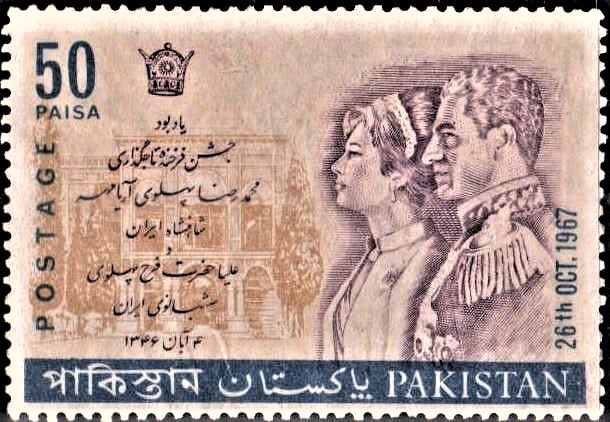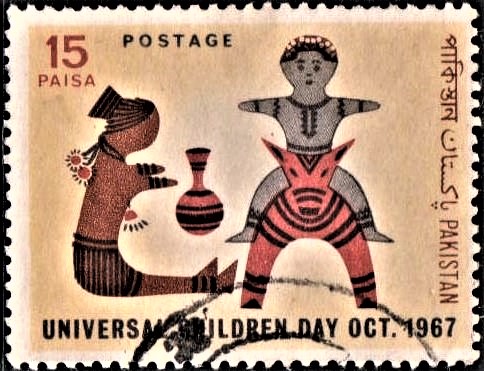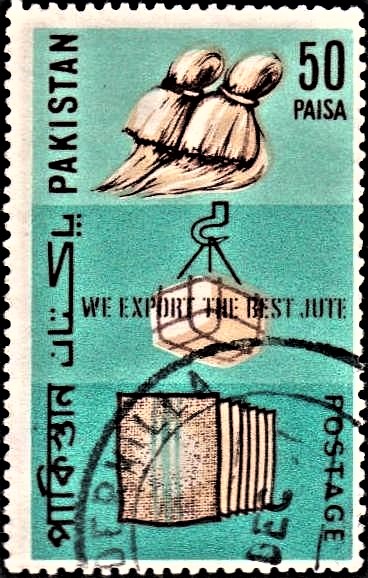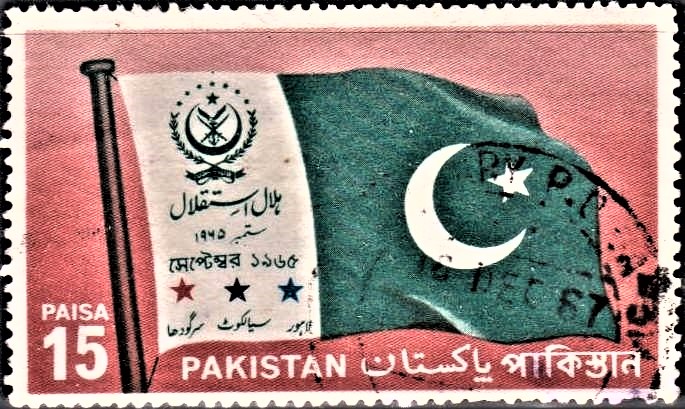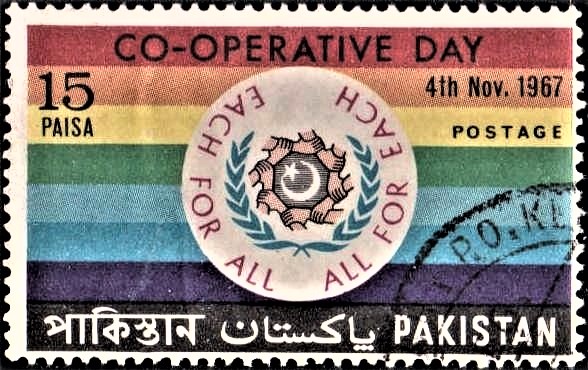
Pakistan Independence Day 1967
A commemorative postage stamp on the 20th Anniversary of Independence of Pakistan :
 Issued by Pakistan
Issued by Pakistan
Issued on Aug 14, 1967
Issued for : To commemorate the 20th Anniversary of Independence, the Pakistan Post Office is issuing one postage stamp of 15 Paisa denomination on 14th August, 1967.
Design : The format of the stamp is rectangular. The figure 20 is prominently displayed, the lower portion of the figure being printed in reverse in the green area and the top portion appearing in light green against a white background. A star appears in red towards the top centre of the stamp with rays radiating from it. The lettering “ th Anniversary of Independence” appears in red, at the top of the stamp the letters “th” are connected with the figure 20. The denomination “15 Paisa” appears in light green in the bottom right corner immediately above the words “Pakistan” in English, Urdu and Bengali which appear in light green at the bottom. “Postage” is printed vertically at left side in light green.
Type : Stamp, Postal Used
Denomination : 15 Paisa
Colour : Green and Red
Size of Stamp : 28 x 40 m.m.
Size of Print : 25 x 37 m.m.
Perforation gauge : 13½ x 13 (c)
Quantity Printed : 15,00,000
Number of Stamps in each sheet : 50
Process of Printing : Photogravure
Printers : The Pakistan Security Printing Corporation Ltd., Karachi
About :
- Ever since the dawn of history, our sub-continent was a source of constant lure to the foreigners, both in the East and the West. She was regarded as one of the richest lands in the world, and it was her silks and spices, pearls and perfumes and ivories and ebonies which fired their imagination and drew them constantly towards shores. The Portuguese were the first people from Europe to find a sea-route to this sub-continent. They were followed by a more clever group of sailors from England who established a permanent factory at Surat in 1613, and later at Madras, Bombay and Calcutta under the aegis of the East India Company. The dawn of the 18th Century saw the beginning of the end of the Mughul might in the Indo-Pakistan sub-continent. The decline and disintegration of political power was rapid which gave rise to an era of anarchy and a chance to the East India Company to build up an Empire, governed from aboard.
- After the battle of Plassey in 1751 in Bengal and the last stand of Tipu Sultan in 1799 in the south, the British acquired a strong foothold in India and their supremacy in the sub-continent was firmly established.
- The last attempt made by the Muslims to recover their power was the unorganised upheaval in 1857, miscalled the Sepoy Mutiny by foreign historians. This upheaval and its disastrous consequences led to the political and economic ruination of the Muslim nation. This was the situation facing Syed Ahmad Khan in 1858 and in the four decades that followed. In 1885 there came into existence a political association which styled itself “The Indian National Congress”. Syed Ahmad Khan closely watched it for three years, and found that it was not liberal enough in its outlook. He was the first Muslim to realise and to state that Hindus and Muslims are really two separate nations. After the death of Syed Ahmad Khan, Nawab Mohsin–ul–Mulk and Nawab Viqar–ul–Mulk became the guiding stars in Muslim Politics. The entire energies of the Muslim Leaders were directed towards organising the Muslims on one political platform, and the first political and social association of the Muslims was formed at Aligarh in 1901. Then at Dacca on December 30, 1906, Nawab Salimullah convened a conference of representative Muslim Leaders all over India and at this conference, presided over by Viqar-ul-Mulk, a resolution to found the All India Muslim League was passed. This was to play a most vital role in shaping the political destiny of the sub-continent. The Khilafat Movement, under the dynamic and inspiring leadership of Maulana Mohammad Ali became a movement of the Muslim masses which paved, in course of time, the way for the Muslim League to be a great popular organisation.
- On October 1930, the Viceroy of the British Indian Empire announced the British Government’s decision to convene a Round Table Conference in London, in which the political leaders of the sub-continent were invited to participate. It was about this time that the annual session of the Muslim League was held in Allahabad with the great poet Dr. Mohammad Iqbal as its President, who, in his presidential address declared, “The Muslim demand for the creation of a Muslim India within India is, therefore, perfectly justified …. I would like to see the Punjab, North-West Frontier Province, Sind and Baluchistan amalgamated into a single State. The formation of a consolidated North-West India Muslim State appears to me to be the final destiny of the Muslims, at least of North-West India …. This will eventually solve the problem of India as well as of Asia”. Later on, in one of his letters to the Quaid–i–Azam, Iqbal also included Bengal in this scheme. By this time Mr. Jinnah, who had temporarily settled down in London, was persuaded to return and take up the leadership of the Muslims. Mr. Jinnah chalked out a more constructive programme. From 1937 to 1947, as a mass organization of the Muslims, the League grew from strength to strength. Its programmes became revolutionary, and in 1937 the Muslim League took the momentous decision to change its aim from attaining responsible government to full independence. At last Iqbal’s concept was accepted, and in 1940 the Pakistan Resolution was passed at the historic session of the All India Muslim League at Lahore. Iqbal had died two years earlier; but his ideological lead was accepted by Mr. Mahomed Ali Jinnah, the Muslim League and the 100 million Muslims of the Indo-Pakistan sub-continent.
- Hence forth the political ideal of the Muslims of India was the attainment of a separate homeland where they could live according to their distinct way of life. In the years that followed Jinnah negotiated with the Cripps Mission on behalf of the Muslims. The result was a failure but it was the first step by the British to agree to the demand for a separate state for the Muslims. The Congress was alarmed and after the failure of the Cripps Mission, they launched the violent ‘Quit India’ campaign against the British in 1942. All this was alien to Jinnah’s nature, and he kept the Muslims clear of all these disturbances. When the European War ended in May 1945, the British Government again started negotiations for constitutional changes in India. First came the Wavell Plan, then the more important Cabinet Mission Plan. Before the latter, an important event was the new elections held in India in January 1946.
- The victory of the Muslim League at the polls was over-whelming. It was a measure of the Quaid’s glorious success in his mission of organizing the Indian Muslims. Well could he declare “No power on earth can prevent Pakistan now”.
- In March 1946, the Cabinet Mission came to India with new proposals, offering to arrange the provinces into three groups, to satisfy Muslim demands partially, for though they were offered internal autonomy, they were to be part of one state with defence, foreign affairs and communications as central subjects. The Quaid went along with the proposals some way but Mr. Jawaharlal Nehru’s intransigence wrecked the negotiations for the Hindus did not appreciate the sacrifice the Muslims were making by scaling down their demands. When the Government decided to hold elections for a new Constituent Assembly, the League’s stand of being the sole representative of the Muslims was vindicated, for it won 76 out of 79 Muslim seats. In October 1946, the League joined in forming the Interim Government. But there was no real co-operation. The Quaid ordered that no Muslim was to take part in the Constituent Assembly due to sit from December 9, 1946. Feelings in the whole of the sub-continent were worked up and the Calcutta riots were like the fuse that started the great explosion. After one last effort to reconcile the Muslims and Hindus, Mr. Attlee, the British Premier, announced in February 1947, that they would grant independence to India. Viscount Mountbatten was sent out as Viceroy to negotiate the manner and handing over power. On June 2, 1947, he announced that India would be partitioned. Thus two new States Pakistan and India were created, Pakistan on August 14, 1947 and India on August 15, 1947. Quaid-i-Azam’s leadership and the struggle of the Muslim nation at last bore fruit – earlier than anyone expected.
- Pakistan began her existence with an under-developed economy and has been, from the very first day of her existence, confronted with obstacles and problems of a great magnitude. Nevertheless, the country has made spectacular progress during the twenty years of its existence, which is reflected in almost every aspect of national life.
- Economy: In 1948-49 the combined expenditure of the central and provincial governments was under Rs. 1,500 million; in 1966-67 it rose to Rs. 11,714 million. Most of it was development expenditure.The GNP rose from Rs. 24,466 million in 1949-50 to Rs. 45,189 million in 1966-67; the per capita income also rose from Rs. 311 to Rs. 381 during the same period; the share of agriculture in the GNP declined from 59.9 percent to 45.8 percent. The share of manufacturing industries during the same period increased from 5.8 to 11.7 percent. A five-fold increase was registered in the Construction sector and seven-field in electricity, gas, water, and sanitary sector between 1949-50 and 1966-67.
- Industrial Development: Considerable progress was made in the field of industrial development. Self-sufficiency has not been attained in a wide range of essential consumer goods, but sizable surplus in certain goods is available for export. The progress is evident from the following figures:
Industrial Production 1954-55 1965-66 Sugar (000 tons) 87 445 Hydrogenated vegetable cooking oil (000 tons) 13 100 Cotton yarn (million lbs) 232 501 Cotton cloth (million yards) 387 691 Jute manufacturers (000 tons) 103 409 Tyres and tubes (000 Nos) 1,800 4,610 Chemical fertilisers (various) (000 tons) — 178.3 Cement (000 tons) 690 1,650 Cigarettes (million Nos) 4,760 26,450 Paper (000 tons) 19.2 41.9 Newsprint (000 tons) — 33.8
Attention is now directed towards setting up heavy and sophisticated industries, such as mechanical and electrical complex, iron and steel, machine-tool, automotive vehicles and petrochemicals. - Social Development: In 1947, hardly six percent of the population were literates; literacy went upto 19.02 percent in 14 years time, in 1961, and is expected to have further risen by now. Nearly 9.6 million students attend different educational and training institutions in the country. There are now 66,000 primary and 8,000 secondary schools, 200 degree colleges, and 12 Universities, including two engineering and two agricultural Universities.There are also 20 polytechnics and about 150 smaller technical institutes, five agricultural, six engineering and 12 medical colleges in the country. Government expenditure on education has increased from Rs. 460 million during the First Plan to Rs. 2,374 million during the Third Plan.
In the health sector, at the end of 1966-67, there were about 16,600 doctors, 4,500 nurses and 36,000 hospital beds. There are also some 200 rural health centres and 3,300 family planning clinics.
Noted progress has been achieved in social welfare, manpower and employment, transport and communication. Yearly 70,000 to 80,000 people are provided with jobs through 22 employment exchanges. Between 1947 and 1966, some 1.66 million dwelling units have been constructed. In community services 1,00,000 tube-wells were sunk for supplying drinking water.
- Constitutional Development: Till October, 1958 Pakistan followed the parliamentary system of western democracy. A completely new system of democracy, more suited to the genius of the people as well as political and economic conditions of the people – the Basic Democracy system – was introduced by President Ayub Khan, in 1959. Under this system 80,000 Basic Democrats are elected in equal half from both provinces on universal adult franchise basis, who in turn elect provincial and national assembly members as well as the President of the country for a five year period. The Union Councils are actively associated with development activities in their respective areas. They have become useful institutions and play a healthy role in the struggle for progress instead of merely indulging in petty politics.
- Foreign Policy: Pakistan’s Foreign Policy, by virtue of her being placed in a crucial position in areas of great political significance in the contemporary world is determined basically by this fact of geography; and strictly adheres to the concepts of equality, and the right of self-determination for all peoples. Except with India which has been persistently refusing to settle the Kashmir dispute which has so long stood in the way of mutual understanding between the two countries, Pakistan maintains friendly and cordial relations with all countries, far and near; and irrespective of ideological differences, supports peoples’ right to freedom and the Afro-Asian cause.Pakistan also maintains special relations with the fellow Muslim countries, strives for Muslim solidarity and has entered into agreements of social, cultural and economic collaboration in the “Regional Co-operation for Development” with Turkey and Iran, and in the “Indonesia-Pakistan Economic and Cultural Co-operation” with Indonesia. Pakistan is wedded to the ideal of world peace based on justice and the principles of U.N. Charter.
- With the compliments of the Director General, Pakistan Post Office, Karachi.


